Choosing the Right Men's Water Shoes for Performance


Intro
Choosing the right water shoes can seem daunting with so many options on the market. They play a crucial role, especially if you find yourself splashing around in rivers, lakes, or oceans. But what does it take to find the best pair? It’s not just about picking whichever ones look cool; you've got to consider durability, comfort, grip, and even style. So, whether you're lounging by the pool or exploring a rocky shoreline, this guide will walk you through everything you need to know about men's water shoes.
Fashion Trends
As we dive into the heart of aquatic footwear, it’s important to explore the latest fashion trends that are shaping water shoes today.
Current Seasonal Trends
For this season, the trend is leaning heavily towards versatility. Modern men's water shoes are designed not only for aquatic activities but also to blend seamlessly into casual wear. Expect to see designs that offer bold colors and patterns, with switch-a-roo functionality allowing for both wet and dry environments. Many brands are featuring breathable meshes and quick-drying materials, a nod to both fashion and function.
A catchy design doesn’t hurt either. Go for vibrant hues or earthy tones that can pair well with shorts or swim trunks. Water shoes that mirror sneaker styles are gaining traction too, making it easier to transition from water activities to walking on dry land without skipping a beat.
Influential Style Icons
Certain figures in the fashion world have helped elevate the status of water shoes. Take, for example, the influence of lifestyle bloggers and athletes who incorporate water shoes into their daily wardrobes. These style icons often showcase how to rock these shoes without looking out of place, inspiring a new generation to embrace them not just for their utility but for their aesthetic appeal.
Sustainable Practices
With an increasing awareness around sustainability, it's essential to examine how various brands are implementing eco-friendly practices when it comes to water shoes.
Eco-friendly Fabrics
The use of recycled materials is becoming standard in the realm of water shoe production. Brands like Crocs and Chaco are leading the charge by implementing fabrics made from recycled plastics, minimizing waste, and promoting a greener footprint. This not only helps the environment but also adds an interesting twist to the design aspect, with unique textures and patterns coming from these materials.
Ethical Fashion Brands
Supporting brands that commit to ethical practices should be high on the priority list for any fashion-savvy consumer. Look for companies that pay their workers fair wages and are transparent about their manufacturing processes. Teva is an example of a brand that puts sustainability first, ensuring that their production methods reflect a commitment to the environment and their workforce. Choosing these brands can make a significant difference in the broader industry.
Epilogue
Finding the best men's water shoes involves keeping one eye on functionality and the other on style and sustainability. From current trends highlighting versatility and aesthetic appeal to essential fabrics and ethical considerations, there’s plenty to think about. With this guide as your compass, navigate through the waters of footwear options and emerge with a pair that meets your every need.
Foreword to Water Shoes
When one thinks of water-friendly footwear, often the mind drifts to flip-flops or standard sneakers. However, this perspective doesn't quite capture the unique blend of performance and utility that water shoes offer. Water shoes are not just a trend; they serve a vital purpose in aquatic activities, from kayaking to beach volleyball. In this part of the guide, we will explore why understanding the nuances of water shoes is indispensable for anyone planning to engage in fun on or near water.
Defining Water Shoes
Water shoes, in essence, are specialized footwear designed to excel in wet conditions. They provide significant advantages over traditional footwear. A well-crafted water shoe is made to protect your feet without restricting movement, allowing for agility on wet rocks or slippery surfaces. This type of shoe typically features drainage ports, quick-drying materials, and a snug fit to prevent slippage. The crux of their definition lies in both adaptability and protection. They strive to balance comfort with the challenges posed by wet environments.
For example, if you happen to be wading through a stream, a quality water shoe will keep sharp rocks at bay while allowing water to drain quickly, preventing the shoe from becoming a soggy mess that weighs you down.
The Role of Water Shoes in Aquatic Activities
Water shoes play a critical role across a variety of aquatic activities. Their specialized design allows wearers to move confidently, whether you are hiking along riversides, embarking on a canoe trip, or setting up a beach camp.
- Safety: The primary role of water shoes is safety. They provide grip on slick surfaces, significantly lowering the risk of slipping or injury. An ideal water shoe should feature a rugged sole to enhance traction, especially on surfaces that could turn slippery unexpectedly.
- Comfort: Extended periods of activity can take a toll on one’s feet. A good pair of water shoes will offer support sufficient enough to ensure comfort, allowing you to fully enjoy your chosen activity without foot fatigue.
- Versatility: Water shoes are not limited to one activity. They can transition from rocky beaches to boardwalks seamlessly. This versatility makes them an indispensable item for anyone who finds enjoyment in various water-related adventures.
- Performance Enhancements: If you’re a more serious athlete, water shoes can enhance your performance by providing a better grip and stability when you’re in and out of the water. For those who kayak or engage in similar sports, the right water shoes can mean the difference between a solid stance and a fall into the drink—or worse, injury.
"The right water shoe can provide not just comfort, but also security and confidence in every step taken in aquatic environments."
Key Features of Quality Men's Water Shoes
When it comes to choosing the right water shoes, understanding their key features is paramount. Quality men's water shoes are not mere accessories; they are critical gear that can enhance performance and safety in various aquatic activities. This section tackles the essential elements that set apart top-notch water shoes, touching on materials, soles, breathability, and how all these factors converge to create a reliable product.
Material Considerations
Selecting water shoes begins with the choice of material. Different materials provide distinct advantages and limitations, which can greatly affect comfort and usability.
Neoprene
Neoprene is a widely used material in water shoes, known for its exceptional insulation properties, which keeps your feet warm even in cooler water conditions. One of the key characteristics of neoprene is its strong resistance to abrasion, making it suitable for rugged terrains. A unique feature is its snug fit—this not only helps eliminate water entry but also provides support during activity. However, neoprene can have a downside: it may retain water, making drying time longer.
Mesh
On the flip side, mesh material is favored for its superior breathability. It allows air to circulate freely, helping your feet stay cool and comfortable. This is particularly beneficial in hot conditions. The quick-drying nature of mesh means it doesn't retain much water, thereby helping keep the weight down when you leave the water. The downside? It tends to be less durable compared to neoprene, and you might find yourself replacing mesh shoes more frequently.
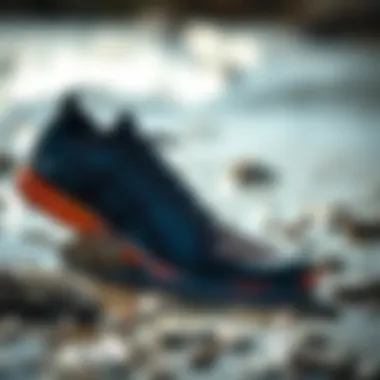

Rubber
Rubber is another significant material in water shoes, especially noted for its durability and excellent grip. Many water shoes feature rubber soles that provide superior traction, reducing the risk of slipping on wet surfaces. One noteworthy aspect of rubber is that it can be molded into various designs, which offers flexibility in styles and functionalities. However, some may find rubber shoes heavier or less breathable compared to those made with other materials.
Sole Construction
The sole of a water shoe plays a critical role in its overall performance. There are essential aspects to consider here, including traction, cushioning, and flexibility.
Traction and Grip
Traction is perhaps the most vital feature of a water shoe's sole. A well-designed sole provides grip, which is crucial when navigating slippery rocks or boat decks. Rubber outsoles with textured patterns enhance grip, giving you confidence as you step. The downside is that if the sole wears out quickly, the value of the water shoe diminishes significantly.
Cushioning
Cushioning impacts comfort, especially during prolonged use. It's important to pick a shoe that offers adequate cushioning to absorb shocks and reduce fatigue. Shoes with EVA foam in the midsole often provide good cushioning. Remember that excessive cushioning can lead to decreased stability, so finding the right balance is key.
Flexibility
Flexibility in a shoe's sole allows for natural foot movement, promoting a more comfortable experience in the water. Shoes that use a flexible design typically allow for a greater range of motion both in and out of the water. However, a sole that's too flexible may sacrifice support and stability, particularly on uneven surfaces.
Breathability and Drying Time
Breathability is essential in water shoes to prevent moisture buildup, which can lead to discomfort and potential fungal issues. Opt for shoes that incorporate materials that dry quickly after exiting the water. Shoes that feature drainage holes can also significantly reduce drying time, ensuring your feet remain as comfortable as possible.
Weight and Packability
The weight of water shoes is another aspect worth considering, especially for those who plan on traveling or hiking. Lightweight shoes are generally easier to pack and carry. However, they should not compromise quality or durability. If you often find yourself moving between water and land, seek shoes that strike a balance between packability and performance.
Purpose and Use Cases
When it comes to selecting the right men’s water shoes, understanding their purpose and use cases is crucial. Knowing where and how to utilize these specialized footwear options can significantly enhance performance and enjoyment in aquatic activities. Each scenario demands different functionalities and features, making it essential to consider your specific activities before making a purchase.
Kayaking and Canoeing
Men's water shoes are an indispensable piece of gear for kayaking and canoeing. These activities often involve moving between the water and shore, demanding footwear that is both comfortable and efficient. Shoes designed for such tasks must provide excellent grip on wet surfaces to avoid slips. An ideal choice would include shoes with a flexible sole, allowing for natural foot movement while paddling. Moreover, water shoes need to drain efficiently to prevent discomfort from water buildup, which can get cumbersome over long distances.
When navigating rocky shores or uneven terrain, shoes featuring reinforced toes can protect your feet from sharp objects. A snug yet breathable fit will also ensure that your feet do not slide around in the shoe, maintaining optimum control while maneuvering your boat, especially in unpredictable waters.
Hiking in Aquatic Environments
Hiking in environments where water is a constant presence—think river trails or coastal paths—requires footwear that can adapt to varied conditions. Water shoes designed with durable, quick-drying materials stand out as practical choices. They should also provide ample support for the hiking trails you plan to tackle. Look for shoes that combine cushioning with traction; this balance is essential for both comfort and stability as you navigate wet rocks and muddy patches.
Additionally, a good water shoe suitable for hiking will often have a toe guard to fend off rocks, roots, and other hiking hazards you might encounter on your journey. Consider also the weight of the shoe; you want something that feels light on your feet but sturdy enough to handle harder terrains.
Beach Activities
Whether you’re building sandcastles, playing beach volleyball, or simply enjoying a walk along the shore, the right pair of water shoes will enhance the beach experience. During these activities, the focus is often on a relaxed feel coupled with sand resistance. Water shoes should not only dry quickly but also provide protection from hot sand and the potential for sharp shells underfoot.
Lightweight models with a secure fit are ideal because you won’t want shoes that come off with every step across the shifting sands. Look for options with a sole designed for traction that can cope with wet sand or rocks, allowing for safer footing during your beach excursions.
Fishing and Boating
For anglers, the inclusion of quality water shoes can’t be overstated. When fishing or moving around on a boat, shoes that dry quickly and offer significant grip on wet surfaces are key components. Moreover, lightweight shoes are preferable since you might be standing for extended periods while casting or waiting for bites. Additionally, shoes that feature slip-resistant soles protect against any unforeseen slips caused by water splashing.
Comfort is equally important; a good pair should allow for ease of movement, helping maintain balance while reeling in a catch. Waterproof materials might also be worth considering if you're frequently wading out into the water, ensuring that your feet remain dry—because discomfort can lead to distraction, potentially affecting your fishing game.
"The right pair of water shoes can make or break your experience, transforming a simple outing into an adventure."
Evaluating Popular Brands
When it comes to choosing the right men's water shoes, evaluating popular brands is an essential step. This isn’t just about picking a name you recognize; it’s about understanding how these brands stack up in terms of quality, performance, and customer satisfaction. Each brand brings its own unique approach, materials, and technology to the table, which can significantly influence your experience on aquatic adventures.
For the buyers, when you know which brands are well-regarded, you're less likely to get caught up in flashy marketing and more focused on what truly matters: functionality and comfort. Here are some important elements that you should consider while evaluating popular brands:
- Reputation: A solid reputation in the market suggests reliability and consistency in product quality.
- Reviews and Testimonials: Customer feedback can paint a realistic picture of how a shoe performs in real-world conditions.
- Innovation: Brands that invest in technology might offer advanced features like enhanced grip or breathable materials, improving your experience on the water.
"In the world of sports shoes, more than just fit is needed; it's the brand's thoughtful approach to design and functionality that stands out."
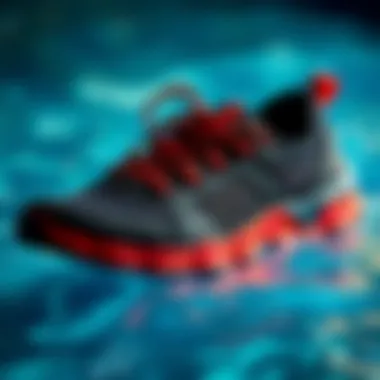
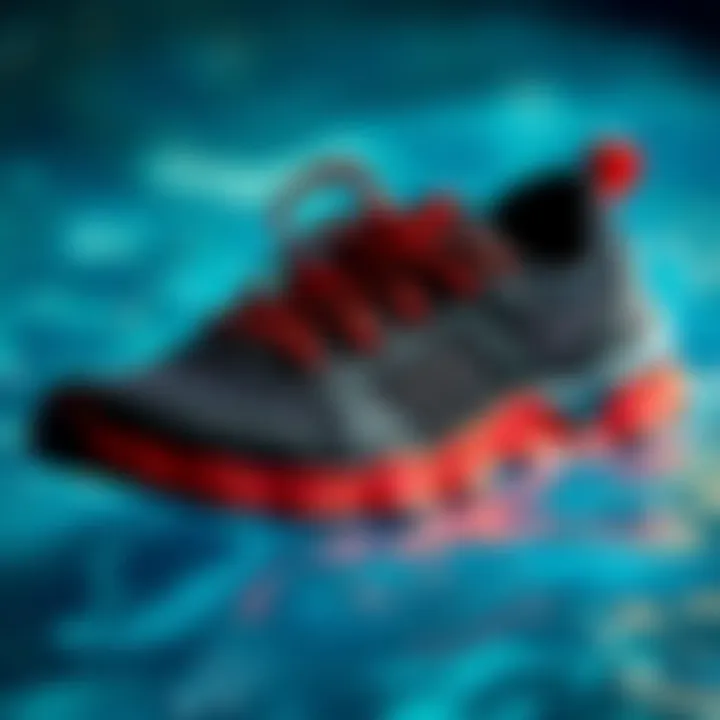
As we dive deeper, let's take a closer look at three significant players in the men's water shoes market.
Brand A: Features and Benefits
Brand A is well-known for combining performance with style. Their water shoes often feature:
- Durable Materials: Using high-quality neoprene and lightweight meshes ensures both comfort and longevity.
- Excellent Traction: The specially designed rubber soles provide unparalleled grip on slippery surfaces, making these shoes a favorite among kayakers and hikers alike.
- Quick Drying: An excellent characteristic, their shoes are built to shed water rapidly, helpful for beach-goers or boaters who want to prevent soggy socks.
The specific models, like the Wave Traveler, showcase these features, with added arch support that caters to both casual wear and dedicated outdoor activities.
Brand B: Customer Insights
Moving on to Brand B, consumer insights reveal a lot about their products' performance. Users frequently highlight:
- Comfort: Many rave about the cushioned footbed, claiming that it feels like walking on clouds even after hours of wear.
- Versatility: These shoes can transition from the water to dry land seamlessly, making them a multitasker for beach outings or camping trips.
- Sizing Accuracy: One aspect that attracts new buyers is the consistent sizing – making returns and exchanges a hassle-free process.
Review forums, like those found on Reddit, are buzzing with talks about how Brand B consistently meets expectations. This indicates a solid brand loyalty based on experience.
Brand C: Comparison of Models
Lastly, Brand C offers a variety of models worth discussing, but let’s focus on a few key distinctions:
- Performance Models vs. Casual Models: Their performance models are cut narrow for a snug fit, ideal for serious athletes, while the casual options are roomier, catering to all-day wear.
- Color and Style Variations: A notable fashion-forward approach, these shoes come in several vibrant colors, appealing to style-conscious consumers who want more than just functionality.
- Price Point Differences: Comparing their budget-friendly models to higher-end options reveals thoughtful engineering and material choices that justify cost variances.
Price Range and Value Assessment
Understanding the price range and value assessment of men's water shoes is crucial for several reasons. First off, with a range of options available, from budget-friendly to premium, it is effortless to get lost in the sea of choices. However, a well-informed consumer can navigate this maze, assessing shoes not just by their prices but by the value they offer.
A critical aspect to consider is the alignment of price with quality. It is essential to understand that a higher price tag doesn’t necessarily guarantee superior performance or durability. While costlier options often come with advanced features and better materials, there are budget options that don’t skimp on quality and can serve adequately for various water activities. Knowing the price-to-value correlation can save you both money and frustration in the long run.
In addition to performance and durability, one has to be mindful of how price affects features, warranty, and customer service. Some brands provide lifetime warranties or a commitment to sustainability, which may justify higher costs. Essentially, this section not only highlights different budgets but elucidates how each price point impacts the consumer experience associated with men’s water shoes.
Budget Options
When budgeting, affordability doesn't have to compromise quality. Budget options in the realm of men's water shoes typically range from $30 to $60. These choices often appeal to casual users who engage in occasional water-based activities like beach days or lakeside picnics.
Key characteristics of budget-friendly shoes include:
- Lightweight design: Generally made with fewer features, these shoes focus on being easy to wear and carry.
- Basic grip: While not as advanced as their pricier counterparts, they usually include a decently patterned sole for traction.
- Quick-drying materials: Many budget options incorporate synthetic materials that dry relatively fast, which is a plus when going from water to land.
A popular choice in this category is the Speedo Surfwalker Pro 3, which blends comfort with performance at a reasonable price.
Mid-Range Selections
Shifting into the mid-range category, prices can vary from about $60 to $120. This price bracket generally provides a balance between quality and performance, making it ideal for avid water sports enthusiasts. Mid-range water shoes usually come equipped with enhanced features that contribute to a more enjoyable experience on the water.
Noteworthy features in mid-range selections often include:
- Superior cushion: Added padding helps absorb impact and improves comfort for longer wear.
- Increased breathability: With mesh panels for airflow, these shoes keep feet cool, reducing the risk of blisters.
- Better traction: Advanced rubber compounds offer enhanced grip on slippery surfaces.
Take, for example, the Merrell All Out Blaze Sieve; it offers added support, durability, and flexibility, making it suitable for hiking and aquatic activities alike.
High-End Choices
For those not constrained by budget, high-end choices start at around $120 and can go well above $200. These shoes cater to serious outdoor adventurers and water sports aficionados who value both performance and technological advancements in footwear.
In the high-end category, expect features like:
- Top-quality materials: High-grade neoprene or special mesh that provides enhanced waterproof abilities and durability.
- Advanced sole technology: These often include proprietary designs for that optimal combination of traction, grip, and flex.
- Customization options: Many premium brands now offer tailored choices, such as adjustable straps for a more secure fit.
An example of such high-end footwear is the Salomon Tech Amphibian 4, which is well-known for its versatility and functionality, perfect for various water activities.
Understanding price ranges helps ensure that consumers make informed decisions based on their needs and activities.
A comprehensive grasp of pricing and value assessment can offer a clearer picture when searching for the ideal pair of men’s water shoes. Whether you prefer to save a few bucks or are ready to splurge, the right pair will not only enhance your performance but add to your enjoyment in the water.
Sustainable Practices in Water Shoe Manufacturing
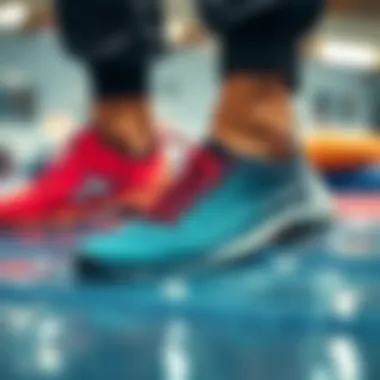
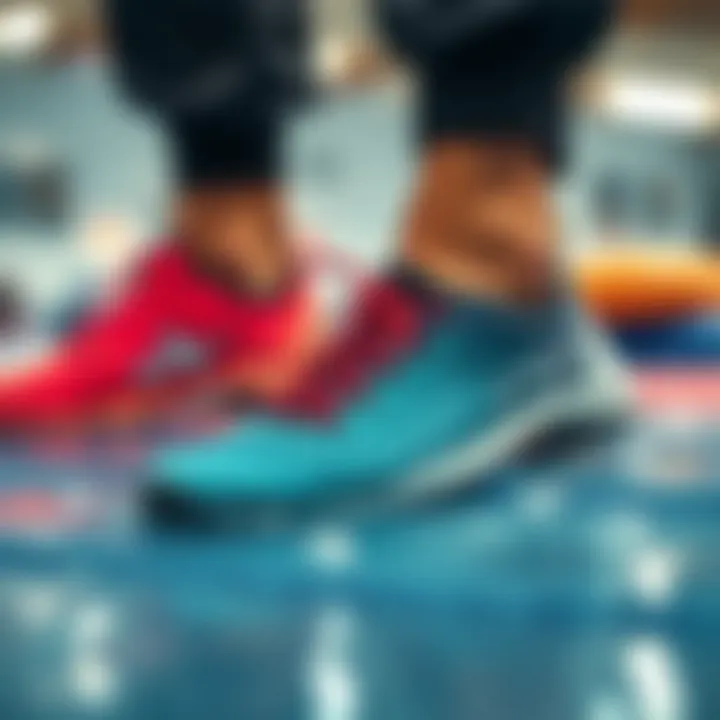
Sustainability isn't just a buzzword tossed around by brands; it's becoming a necessity in today's world. As aquatics enthusiasts seek quality and performance, they’re also looking for those shoes that don’t leave a heavy footprint on the planet. This section dives into how the manufacturing of water shoes can marry function with eco-friendliness, ensuring that consumers don’t have to sacrifice one for the other. The importance of sustainable manufacturing practices can’t be understated, especially for those who care about the environmental impact of their purchases.
Materials Sourcing
When it comes to sourcing materials, the focus should shift towards those that are sustainable and responsibly sourced. Brands have started to turn their eyes towards recycled materials, which can drastically reduce the amount of plastic waste entering landfills. For example, some manufacturers use recycled plastic bottles to create high-quality mesh fabrics for water shoes. Not only does this minimize environmental harm, but it also breathes new life into materials that would otherwise be discarded.
Another consideration is the sourcing of natural or organic materials such as rubber or cotton. Where possible, water shoe producers should look for suppliers who engage in responsible harvesting practices. Using these materials not only reduces the need for synthetic compounds but also supports agricultural systems that treat the Earth gently.
"The best way to ensure a sustainable future is to rethink our current buying habits; choosing eco-friendly products can lead to a significant environmental impact."
Eco-Friendly Technologies
As technology advances, so do the methods for creating sustainable footwear. Innovations in production processes can result in less waste and water usage. For example, some brands employ 3D printing techniques to make components of their shoes. This method allows for precise designs that cut down on excess material and energy consumption.
Another area witnessing growth is the use of water-based adhesives instead of traditional solvents. These adhesives help create less volatile organic compounds in the manufacturing process, contributing to a healthier environment for factory workers and consumers alike.
It's worth noting that some manufacturers are even leveraging bio-based materials, which consume fewer fossil fuels compared to conventional materials. This can include plant-based plastics or other components that aim to lessen ecological impact.
Lifecycle of Water Shoes
Understanding the entire lifecycle of water shoes—from production to disposal—is crucial in assessing their overall sustainability. It begins with sustainable materials and ends with smart disposal or recycling solutions. Consumers need to think about how their shoes will be disposed of when they’ve worn out.
Many brands now advocate for take-back programs where old shoes can be returned for recycling or repurposing. This initiative not only diverts waste from landfills but also reinforces the circular economy, encouraging consumers to think beyond just the immediate use of a product.
By recognizing the product lifecycle, consumers can make better choices and support brands that prioritize sustainability. As new measures and technologies enter the scene, the hope is that soon, environmentally conscious water shoes will become the standard rather than the exception.
Choosing sustainable practices in water shoe manufacturing aligns not just with consumer ethics, but also reflects a growing demand for products that resonate with our shared values around sustainability. The synergy of quality design and eco-friendly materials creates a compelling narrative for potential buyers in this ever-competitive market.
Caring for Men's Water Shoes
Caring for men’s water shoes is not merely a matter of cleanliness; it plays a crucial role in prolonging the life and maintaining the performance of these specialized footwear. Proper care ensures that your shoes remain effective for your aquatic escapades, be it while kayaking, fishing, or simply enjoying a day at the beach. With the right habits, you can enhance the durability and functionality of your water shoes, making your investment truly worthwhile.
Cleaning Techniques
To keep your water shoes in top-notch condition, regular cleaning is pivotal. After all, nobody likes the stench of mildew wafting from their footwear. Here are some effective cleaning techniques to consider:
- Rinse immediately: As soon as you exit the water, give your shoes a good rinse. This removes sand, salt, and any debris that could lead to damage over time.
- Gentle scrub: Use a soft-bristled brush or a cloth to scrub the surfaces. Particularly focus on areas where dirt tends to accumulate, such as the soles.
- Mild detergent: A mixture of warm water and a small amount of mild detergent works wonders. Avoid harsh chemicals, as these can erode the materials and harm the shoe’s structure.
- Dry thoroughly: After cleaning, ensure your shoes dry completely in a well-ventilated area, away from direct sunlight which can warp materials. Avoid throwing them in the dryer, as this can damage the integrity of the shoe.
"Maintaining clean water shoes not only enhances their lifespan but also ensures optimal performance during your adventures."
Storage Recommendations
Proper storage is just as essential as cleaning, especially if you want your water shoes to remain in good shape when not in use. Here’s what you should keep in mind:
- Avoid damp areas: Store your shoes in a cool, dry place. This helps prevent mold and bad odors.
- Use a shoe rack or box: Keeping them off the floor and in a designated container helps protect them from dust and potential damage. It also prevents other shoes or items from crushing them.
- Air them out: Every once in a while, leave your shoes out to air. This helps refresh them and evaporate any lingering moisture.
- Packing for trips: When traveling, consider using a breathable bag designed for footwear. This allows for air circulation instead of trapping moisture.
By integrating proper cleaning techniques and following effective storage recommendations, men’s water shoes can last longer, perform better, and maintain their appearance. It's a small investment of time that yields big results in your aquatic adventures.
Closure
In this article, we've traversed the essentials of selecting the best water shoes for men, spotlighting the significance of careful consideration in a variety of factors affecting both performance and comfort. The key elements we've discussed aren't merely incidental; they form the very foundation of what makes a water shoe suitable for diverse aquatic environments.
Choosing the right water shoes can greatly impact your enjoyment and performance during activities such as kayaking, beach outings, or even a casual stroll by the shore. Having outlined the attributes—such as material, sole construction, and breathability—that contribute to overall effectiveness, it’s clear that these shoes are more than just a fashion statement; they serve a purpose.
"Selecting the right water shoes is about finding the balance between comfort, functionality, and style."
When it comes to factors likened to durability and adaptability in changing conditions, one must not overlook how crucial these aspects are. Furthermore, the growing trend toward sustainability is a significant consideration as you make your choice. Consumers are now clued-up about the environmental impact of their purchases; thus, opting for brands that incorporate sustainable practices reflects positively on individual preferences and values.
Finally, our exploration hasn’t just scratched the surface but rather delved into the nitty-gritty of water shoes. This comprehensive guide equips you with the necessary insights to thoughtfully assess options in the market, ensuring that whatever your water adventure entails, your feet are well cared for.
Recap of Key Points
We’ve unpacked several important insights within the previous sections:
- Definition and Purpose: Water shoes cater specifically to aquatic activities, offering support and protection.
- Key Features: Materials like neoprene, mesh construction, proper sole properties, breathability, and packability were essential traits highlighted.
- Brand Evaluations: Popular brands were broken down concerning features, customer insights, and the comparisons of different models.
- Pricing: Understanding your budget—whether going for budget options, mid-range selections, or high-end choices—allows for informed decision-making.
- Caring for Footwear: Cleaning and storage practices can prolong the lifespan of your water shoes.
Final Thoughts on Selecting Water Shoes
To find the best men's water shoes that meet your specific needs, it’s vital to weigh the pros and cons of each feature discussed. Take into account the primary activities you’ll engage in and choose a pair that blends functionality with personal style.
Moreover, don’t shy away from investing a little extra in quality; well-made shoes can be the difference between comfort and discomfort during water activities.
As you step into your next adventure, equipped with the right pair of water shoes, remember—great footwear goes hand-in-hand with great experiences. So, make an informed choice, and let your aquatic explorations be fun-filled and worry-free.















